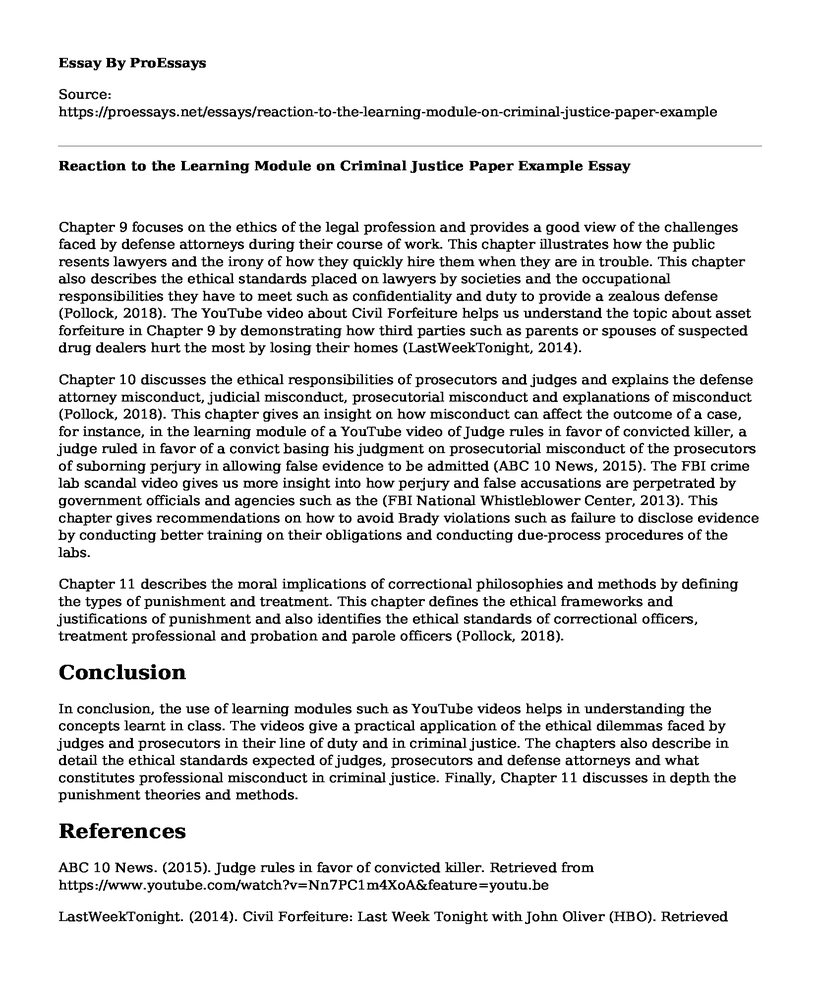Chapter 9 focuses on the ethics of the legal profession and provides a good view of the challenges faced by defense attorneys during their course of work. This chapter illustrates how the public resents lawyers and the irony of how they quickly hire them when they are in trouble. This chapter also describes the ethical standards placed on lawyers by societies and the occupational responsibilities they have to meet such as confidentiality and duty to provide a zealous defense (Pollock, 2018). The YouTube video about Civil Forfeiture helps us understand the topic about asset forfeiture in Chapter 9 by demonstrating how third parties such as parents or spouses of suspected drug dealers hurt the most by losing their homes (LastWeekTonight, 2014).
Chapter 10 discusses the ethical responsibilities of prosecutors and judges and explains the defense attorney misconduct, judicial misconduct, prosecutorial misconduct and explanations of misconduct (Pollock, 2018). This chapter gives an insight on how misconduct can affect the outcome of a case, for instance, in the learning module of a YouTube video of Judge rules in favor of convicted killer, a judge ruled in favor of a convict basing his judgment on prosecutorial misconduct of the prosecutors of suborning perjury in allowing false evidence to be admitted (ABC 10 News, 2015). The FBI crime lab scandal video gives us more insight into how perjury and false accusations are perpetrated by government officials and agencies such as the (FBI National Whistleblower Center, 2013). This chapter gives recommendations on how to avoid Brady violations such as failure to disclose evidence by conducting better training on their obligations and conducting due-process procedures of the labs.
Chapter 11 describes the moral implications of correctional philosophies and methods by defining the types of punishment and treatment. This chapter defines the ethical frameworks and justifications of punishment and also identifies the ethical standards of correctional officers, treatment professional and probation and parole officers (Pollock, 2018).
Conclusion
In conclusion, the use of learning modules such as YouTube videos helps in understanding the concepts learnt in class. The videos give a practical application of the ethical dilemmas faced by judges and prosecutors in their line of duty and in criminal justice. The chapters also describe in detail the ethical standards expected of judges, prosecutors and defense attorneys and what constitutes professional misconduct in criminal justice. Finally, Chapter 11 discusses in depth the punishment theories and methods.
References
ABC 10 News. (2015). Judge rules in favor of convicted killer. Retrieved from https://www.youtube.com/watch?v=Nn7PC1m4XoA&feature=youtu.be
LastWeekTonight. (2014). Civil Forfeiture: Last Week Tonight with John Oliver (HBO). Retrieved from https://www.youtube.com/watch?v=3kEpZWGgJks&feature=youtu.be
National Whistleblower Center. (2013). FBI Crime Lab Scandal. Retrieved from https://www.youtube.com/watch?v=f2168lwQLDc&feature=youtu.be
Pollock, J. (2018). Ethical Dilemmas and Decisions in Criminal Justice (10th ed.). Boston: Cengage Learning, Inc.
Cite this page
Reaction to the Learning Module on Criminal Justice Paper Example. (2022, Nov 20). Retrieved from https://proessays.net/essays/reaction-to-the-learning-module-on-criminal-justice-paper-example
If you are the original author of this essay and no longer wish to have it published on the ProEssays website, please click below to request its removal:
- Gun Control: An American Right Essay
- Paper Example on Juvenile Justice and Delinquency
- How the Children were Affected by World War 1 - Paper Example
- Essay on Justification of Standardized Tests in Georgia State
- Cash Bail System in California Law Courts - Report Sample
- Gideon v. Wainwright: Right to Representation in Capital Offenses - Free Paper Example
- Changing the School Climate - Essay Sample







